Digital Resources for the Study of Early Maps
From cave maps to vellum maps to printed maps, early cartography provides a wealth of insight into past cultures: Behind the dust of age, we find ancient ideas of sovereignty, science, and even sea monsters. The "standard" map was not inevitable, and only by studying maps from sundry times and places can we appreciate the infinite ways in which the world can be drawn.
Thanks to digital technologies, we now have these maps at our fingertips. Below you will find a curated list of digital resources to help you explore the wonderful world of early maps.
University Libraries
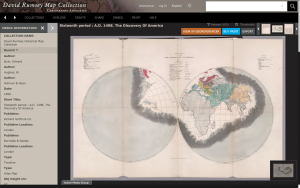
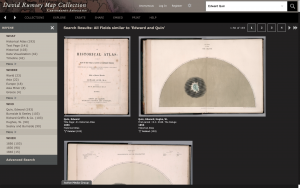
David Rumsey Map Collection (Stanford University)
The David Rumsey Map Collection, archived in the Stanford Digital Repository, boasts more than 100,000 digitized maps ranging in date from around 1550 to the present. While the collection “focuses on rare 16th through 21st century maps of North and South America,” it includes thousands of maps and related materials from around the world. Maps are scanned at 300 to 800 pixels per inch, and all images from the website “may be reproduced or transmitted, but not for commercial use.”
Catalog data accompany each map, including the author(s), year of publication, publisher, publisher location, brief notes, and other details. Many of these fields enable further exploration: Clicking the author allows visitors to search for all maps associated with that author, clicking the date allows visitors to search for all maps published in that year, and so on and so forth. For maps appearing in books, thumbnails at the top of the viewer provide previews of pages belonging to the same book. Unfortunately, the website provides little additional context: It does not note unique features of maps or include mapmaker biographies.
Notably, the website is powered by LUNA Imaging and permits extremely high-resolution downloads, with options to export “Extra-extra Large” files up to 12288 px, “Small Thumbnail” files up to 96 px, and various other file sizes in between. Another unique feature of the website is its highly image-oriented search results: Whereas most digital catalogs display the full titles of maps alongside small thumbnails, the David Rumsey website’s search results prioritize the content of the map rather than its catalog data.
An affiliated website, Old Maps Online, uses georeferencing so that users can view historical maps on top of Google Maps.
Harvard Map Collection (Harvard University)
The Harvard Map Collection boasts 2,759 digitized maps and atlases. “Places that are well represented” include Boston and Cambridge, New England, New York, London, Paris, and Japan. Highlighted themes include urban areas, navigational atlases, the American Civil War, and colonial North America.
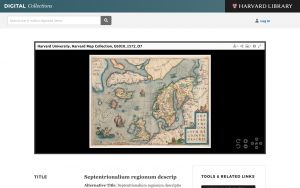

Catalog data accompany each map, but unlike the David Rumsey collection, the Harvard collection does not have feature clickable data fields. The zoomable map viewer is powered by the International Image Interoperability Framework (IIIF), which frames individual maps in a smaller window but provides quick access to other maps in the same book. These accompanying maps are displayed prominently at the bottom of a given map and are scrollable. To the upper right of any given map are download options ranging from “Small” to “X-Large.”
Notably, to the upper left of some of the maps is an option to slot in another map for side-by-side comparison. Such comparison enables researchers to understand how cartographic knowledge evolved over time. Unfortunately, like the David Rumsey collection, the website provides little context on maps other than brief catalog descriptions.
PJ Mode Collection (Cornell University)
The PJ Mode Collection, housed at Cornell University, boasts a unique selection of “persuasive cartography”: more than 800 digitized maps intended to send moral, political, and commercial messages. The collection “reflects a variety of persuasive tools, including allegorical, satirical and pictorial mapping; selective inclusion; unusual use of projections, color, graphics and text; and intentional deception.”
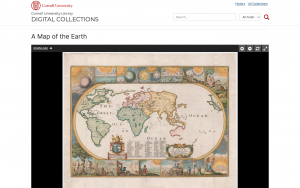
Like most other university library catalogs, the PJ Mode Collection provides various data fields for each map, some of which are clickable and can thus be used to find related maps in the collection. Maps can only be downloaded in a single size, but the downloads are high-resolution.
Notably, the “Collector’s Notes” accompanying each map are more thorough than those of many other university catalogs and even include in-text citations.
Digital Bodleian (University of Oxford)
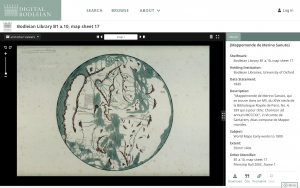
The “Maps and Atlases” category of the University of Oxford's Digital Bodleian collection boasts nearly 500 digitized maps “from all parts of the globe, with topographic and thematic maps dating from medieval times to the present day.” While the website does not provide particularly high-resolution downloads, it allows visitors to use three different viewing technologies: The International Image Interoperability Framework (IIIF), Mirador, and The Universal Viewer. Catalog data accompany each map, but the fields are not clickable.
Notably, the Mirador viewer provides a unique degree of image manipulation: Users can switch to grayscale, invert colors, and adjust the brightness, contrast, or saturation of selected maps. To the upper right of each map, users can also click “Change Layout” to view several maps at once in a grid of their desired dimensions.

Virtual Globes Museum (Eötvös Loránd University)
The Virtual Globes Museum, founded and maintained at the Eötvös Loránd University's Department of Cartography and Geoinformatics, is “considered to be one of the largest projects related to globe digitization.” It boasts over one hundred digitized globes, all of which are both steerable and zoomable. Detailed catalog data accompany each globe.
Notably, each interactive globe comes with a downloadable KMZ file that can be opened as a layer in Google Earth.
The History of Cartography (University of Wisconsin-Madison)
The first three volumes of the History of Cartography, a seminal work, are available for free online thanks to the History of Cartography Project at UW-Madison. All volumes can be simultaneously searched.
- Volume One discusses cartography in Prehistoric, Ancient, and Medieval Europe and the Mediterranean
- Volume Two discusses cartography in the traditional Islamic, South Asian, East Asian, Southeast Asian, African, American, Arctic, Australian, and Pacific Societies
- Volume Three discusses cartography in the European Renaissance
These works provide much of the context for understanding the individual maps featured in other digital resources.
National Libraries
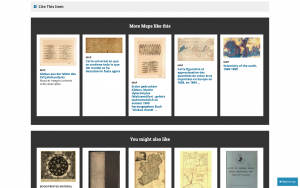
Library of Congress (United States)
The Library of Congress boasts more than 55,000 digitized maps and is organized into themes such as the American Revolution, the Civil War, fire insurance maps, land cession maps, panoramic maps, railroad maps, and more. While these curated collections are Americentric, the map collection as a whole is far more diverse. All maps “were either published prior to 1922, produced by the United States government, or both,” and the Library of Congress is “providing access to these materials for educational and research purposes.”
Cataloging data accompany each map, and some of these data fields are clickable to enable further exploration. The default search view is a list, but results can also be viewed as a gallery with snippets of cataloging data, as an image-only grid, or even as a slideshow. Maps can be downloaded in a variety of high-resolution file formats, including JPEG, GIF, and TIFF.
Notably, each map page includes a “More Maps like this” section and a “You might also like” section. Each clickable recommendation includes a small thumbnail and the title of the map.
Virtual Mappa (British Library + University of Pennsylvania)
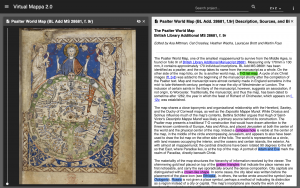
The Virtual Mappa project is an “ongoing set of networked digital editions of medieval maps, published as open access scholarship.” Each map included in the project is “linked to an annotation that includes a transcription, translation, and additional notes.” As is typical of medieval European maps, the included maps predominantly follow the T-O style.
Notably, these annotations are far more comprehensive than those of most digital resources. Not only are the map descriptions unusually detailed, but they are also accompanied by full bibliographies. The map viewer itself is heavily highlighted to denote inscriptions, scribal details, erasures, and other features.
Mapseller Collections
Barry Lawrence Ruderman Antique Maps
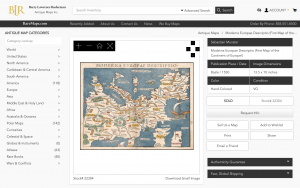
The Barry Lawrence Ruderman collection boasts “around 10,000 authentic antique maps, sea charts, and atlases” dating from the 15th to 20th centuries. Like other mapsellers, the website does not provide free high-resolution downloads, but the maps are zoomable even in full screen.
Notably, Barry Lawrence Ruderman provides unusually detailed context about most maps in its catalog. Not only do maps often come with several paragraphs of descriptions, but they also come with mapmaker biographies.
Daniel Crouch Rare Books
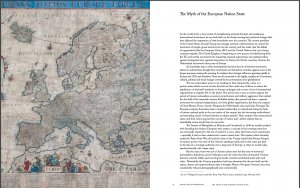
The Daniel Crouch Rare Books collection boasts hundreds of maps and atlases dating from the 15th to the 19th centuries. Its search results are highly image-oriented rather than text-oriented, and like Barry Lawrence Ruderman Antique Maps, it provides unusually detailed context on individual maps.
Notably, Daniel Crouch Rare Books often sells whole atlases rather than individual maps. Not only does the website provide a glossary and mapmaker biographies, but it also curates thematic catalogs. These book-length documents are available for free in PDF format.
Miscellaneous Collections
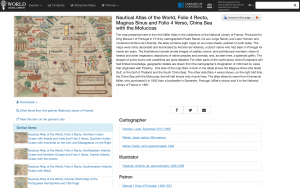
World Digital Library
The World Digital Library brings together more than a thousand maps, atlases, and other cultural documents from dozens of partner institutions around the world. Operated by UNESCO and the United States Library of Congress, its items date as far back as 8,000 BCE.
Maps are accompanied by moderately detailed and well-cited descriptions. “Similar Items” are recommended below, as are other items from the same partner institution. Maps can be downloaded in high resolution, but only in one size. The majority of cataloging data fields are clickable to facilitate further exploration.
Notably, a button at the top of each map allows users to “Listen to this page” thanks to ReadSpeaker. A digital map at the bottom of the page also allows users to orient the depicted locations relative to the rest of the world.
Google Arts & Culture

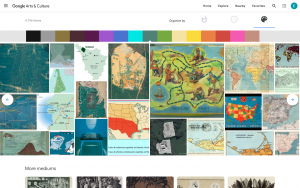
Google Arts & Culture features maps from hundreds of museums and archives who have partnered with the Google Cultural Institute.
Notably, maps can be searched by color, not only by creator, date, or other common data fields. The gallery can also be sorted by popularity.

myoldmaps.com
myoldmaps.com, created by Jim Siebold, grew from Siebold’s frustration that descriptions of significant maps were often unaccompanied images, and vice versa. Over the past two decades, Siebold has written 7,010 pages of well-researched monographs spanning five volumes, all available for free online.
- Book I discusses ancient maps
- Book II discusses early medieval maps
- Book III discusses late medieval maps
- Book IV discusses Renaissance maps
- Book V discusses miscellaneous themes
Individual monographs can be accessed from the home page of Siebold’s website, and all include a full reference list.